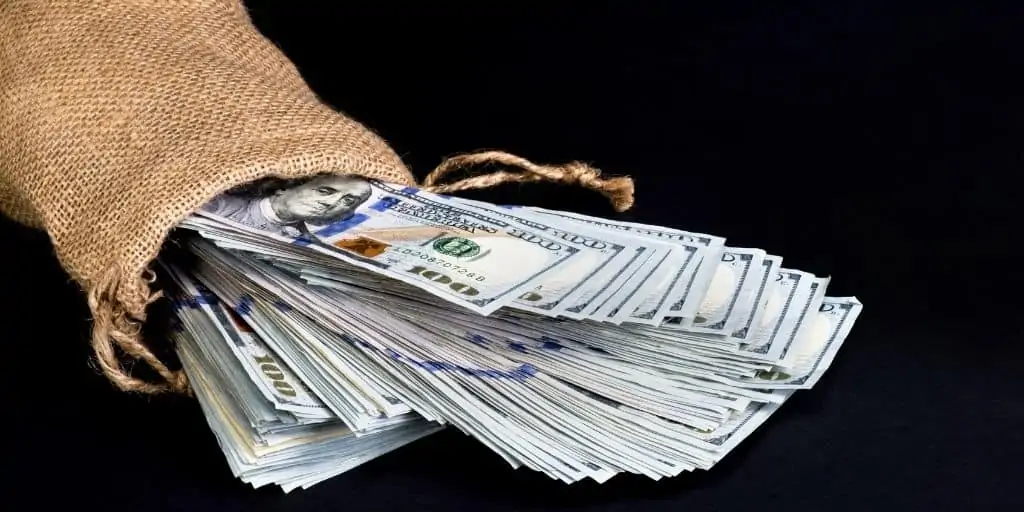What Is a Piggyback Mortgage?
REtipster does not provide tax, investment, or financial advice. Always seek the help of a licensed financial professional before taking action.
How Does a Piggyback Mortgage Work?
A piggyback mortgage is an additional home loan taken out at the same time as a primary mortgage. However, it sits in the second loan position, hence the term “piggyback.”

This piggyback loan is often used if the borrower requires additional money—such as for the down payment on a mortgage—without having to pay for private mortgage insurance (PMI)[1], and usually secured by the same collateral (most often the borrower’s home).
Because mortgage insurance is typically required on down payments of less than 20%, a piggyback mortgage allows a borrower to obtain additional funds to meet the 20% requirement, while two mortgage loans mean more debt, the mortgage insurance premiums often end up being more costly.
Piggyback mortgages usually come in the form of a home equity line of credit (HELOC)[2] or a home equity loan[3].
A borrower does not necessarily have to use the same lender to qualify for both mortgages; for example, a third party may grant credit for the piggyback. However, the first mortgage lender typically refers the borrower to a piggyback lender to secure additional financing.
How Piggyback Mortgages Are Calculated
Lenders use different ways to determine the amount of a piggyback loan. The most common are the 80/10/10, 75/15/10, and 80/15/5 ratios, where:
- The first number (80 or 75) is the main or primary mortgage;
- The second number (10 or 15) is the piggyback amount; and
- The last number (10 or 5) is the down payment amount.
Suppose a borrower wants to buy a $450,000 house. If the lender uses the 80/10/10 formula, the breakdown of the cost looks something like:
- Loan size: $360,000.
Piggyback amount: $45,000.
Down payment: $45,000.
Since 100% mortgage financing[4] fell out of favor following the 2008 financial crisis[5], 80/20 programs are not as popular as they once were. However, zero-down home loans, including 80/20 piggyback loans[6], are making a comeback[7].
Are Interest Rates Higher on Piggyback Mortgages?
Piggyback loans can cost more to borrow since they are tied to short-term interest rates[8].
In addition, secondary mortgage lenders tend to charge more interest because they absorb more risk by extending credit due to lien priority[9]. For instance, if the home sale proceeds are insufficient for both lenders, the second one will absorb the loss. The risk of being unable to recoup the cost is a strong motivation for any piggyback lender to demand a higher rate.
However, borrowers can still save on interest by taking out two mortgages instead of one.
A piggyback can help a borrower take out a primary home loan with a lower loan-to-value (LTV) ratio[10], resulting in a more favorable rate. This mortgage strategy can be useful when buying property viewed as less desirable collateral, like a condominium unit[11].
Is a Piggyback Loan Cheaper Than PMI?
It is difficult to tell without using a mortgage calculator because every borrower has a unique situation.
How much the borrower pays for mortgage insurance depends on the type of mortgage, the LTV ratio, the borrower’s credit score, and the insurer. Generally speaking, however, the PMI is around 0.2% to 2%[12] of the home loan.
Ideally, a borrower can save money using two loans to avoid paying PMI. The difference can be negligible, but the total savings can reach thousands of dollars. Plus, the savings will even be more substantial if a borrower pays off a piggyback loan early[13] without penalty[14].
Negotiation[15] can also factor into how much the final amount the borrower has to pay in a piggyback situation relative to a mortgage with PMI.
BY THE NUMBERS: A PMI can increase the monthly mortgage payment by $30 to $70 for every $100,000 borrowed.
Source: Freddie Mac
What Happens When Borrowers Default on a Piggyback Mortgage
Whether the main or the piggyback, defaulting on a mortgage can be disastrous.
At best, it will drive down a delinquent borrower’s credit score for a time. Although late payments generally become less detrimental to creditworthiness over time, it can be up to seven years before its effects are expunged from the borrower’s credit history[16].
On the other hand, the worst-case scenario will result in foreclosure—even if the borrower is current on the first mortgage[17]. In this case, the borrower will lose the property and suffer a significant credit score deduction. The higher one’s credit score, the harder it drops[18].
Plus, like late payments, foreclosures take seven years to disappear from credit reports[19].
Theoretically, the second lender can foreclose on the property to recoup any losses (after at least four missed payments). In reality, however, the piggyback loan provider is less keen on foreclosure.
One reason is that selling the collateral can backfire when the house fails to fetch an adequate price to cover the expenses associated with the transaction and pay off both home loans in full.
Since the primary mortgage takes priority over the piggyback loan, there may not be enough cash left for the second lender.
Therefore, the piggyback loan provider is more likely to negotiate a more favorable repayment plan.
Are Second Mortgages a Good Idea?
A piggyback mortgage is useful for skirting jumbo loan requirements. For example, a borrower who goes over the Federal Housing Finance Agency’s borrowing limits[20] will face stricter criteria and higher interest rates. Splitting the mortgage loan into two home loans provides a convenient workaround.
That said, taking out two mortgages simultaneously is extremely risky. After all, lending requirements are explicitly designed to disqualify borrowers who are not financially ready to buy properties they intend to own. A piggyback mortgage bypasses these requirements, for good or ill.
In addition, two mortgages can mean that the borrower has to deal with two sets of closing costs, which can be paid upfront or added to the loan amounts[21]. Either way, paying these fees two times in one go can make home financing a bit more expensive overall.
Takeaways
- A piggyback mortgage is a second mortgage that sits behind the primary one, used to obtain additional money to finance a home purchase.
- Borrowers who are short of the down payment amount usually take out a piggyback mortgage, either from the same lender or a referral, to avoid paying mortgage insurance.
- Piggyback lenders usually charge higher interest rates to make up for the greater risk they have to take on. Sometimes, taking out a piggyback mortgage can be more expensive than paying for mortgage insurance.
Sources
- Consumer Financial Protection Bureau. (2020.) What is private mortgage insurance? Retrieved from https://www.consumerfinance.gov/ask-cfpb/what-is-private-mortgage-insurance-en-122/
- Bank of America. (2018.) What is a home equity line of credit (HELOC)? Retrieved from https://www.bankofamerica.com/mortgage/learn/what-is-a-home-equity-line-of-credit/
- U.S. Bank. (2021.) How does a home equity loan work? Retrieved from https://www.usbank.com/home-loans/home-equity/how-home-equity-loans-work.html
- Turner, J. (2020.) Zero Down Mortgages: Are They Right For You? Zillow. Retrieved from https://www.zillow.com/mortgage-learning/zero-down-payment-mortgage/
- Weinberg, J. (n.d.) The Great Recession and Its Aftermath. Federal Reserve History. Retrieved from https://www.federalreservehistory.org/essays/great-recession-and-its-aftermath
- Robertson, C. (2016.) California Credit Union Launches 80/20 Piggyback Mortgage. The Truth About Mortgage. Retrieved from https://www.thetruthaboutmortgage.com/california-credit-union-launches-8020-piggyback-mortgage/
- Lazerson, J. (2021.) Zero-down mortgages are back a decade after mortgage meltdown. Orange County Register. Retrieved from https://www.ocregister.com/2021/07/08/zero-down-mortgages-are-back-a-decade-after-mortgage-meltdown/
- OECD Data. (n.d.) Short-term interest rates. Retrieved from https://data.oecd.org/interest/short-term-interest-rates.htm
- Loftsgordon, A. (2021.) What Is Lien Priority? Nolo. Retrieved from https://www.nolo.com/legal-encyclopedia/what-is-lien-priority.html
- Mortgage Required. (n.d.) What does Loan to Value (LTV) mean? Retrieved from https://mortgagerequired.com/news/what-does-loan-to-value-ltv-mean
- Maduro, J. (2021.) Buying a Condo in 2022: Here’s What You Should Know. LendingTree. Retrieved from https://www.lendingtree.com/home/mortgage/getting-a-mortgage-for-a-condo/
- DeNicola, L. (2021.) How Much Does Private Mortgage Insurance (PMI) Cost? Experian. Retrieved from https://www.experian.com/blogs/ask-experian/how-much-does-private-mortgage-insurance-pmi-cost/
- Tarpley, L. (2021.) Paying off your mortgage early helps you save money in the long run, but it isn’t for everyone. Business Insider. Retrieved from https://www.businessinsider.com/personal-finance/paying-off-mortgage-early-pros-cons
- Meenan, D. (2022.) What Are Soft and Hard Mortgage Prepayment Penalties? RISMedia. Retrieved from https://www.rismedia.com/2022/03/31/what-are-soft-and-hard-mortgage-prepayment-penalties/
- Mastroeni, T. (2021.) 8 strategies for negotiating better mortgage rates. Fox Business. Retrieved from https://www.foxbusiness.com/money/how-to-negotiate-better-mortgage-rate
- Yates, R. (2020.) How Long Do Late Payments Stay on Your Credit Report. The Lenders Network. Retrieved from https://thelendersnetwork.com/how-long-do-late-payments-stay-on-credit-report/
- Garner, R. (2012.) Can a second mortgage foreclose? WalletHub. Retrieved from https://wallethub.com/answers/hl/second-mortgage-foreclosure-79/
- Gaskin, J. (2011.) Research Looks at How Mortgage Delinquencies Affect Scores. FICO. Retrieved from https://www.fico.com/blogs/research-looks-how-mortgage-delinquencies-affect-scores
- Gravier, E. (2020.) Foreclosure can cause your credit score to drop 100-plus points—here’s how to recover. CNBC Select. Retrieved from https://www.cnbc.com/select/how-long-does-foreclosure-stay-on-your-credit-report/
- Federal Housing Finance Agency. (n.d.) Conforming Loan Limits. Retrieved from https://www.fhfa.gov/DataTools/Downloads/Pages/Conforming-Loan-Limits.aspx
- Amerifirst. (2022.) 5 Ways to Fund Closing Costs. Retrieved from https://www.amerifirst.com/amerifirst-blog/bid/65151/5-Way-to-Fund-Closing-Costs







